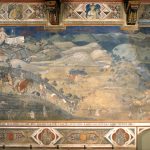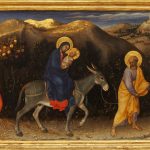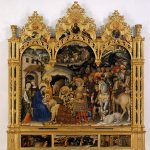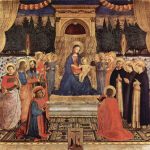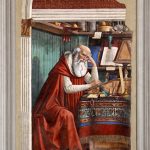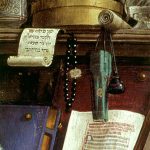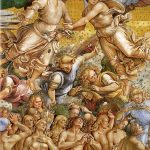The notion of a solitary artist hidden away in his or her studio, expressing an idea in visual form for exhibition or for someone to perhaps purchase on spec, was uncommon in the Renaissance. This might have been true of small devotional images and domestic items, but larger scale works and portraits were made on commission. This was a culture that was so different from our own that we can scarcely imagine it, especially when we are standing in front of a Renaissance painting in an art gallery, away from the original context and one that imbued it with its meaning.
Also, Renaissance art production was a co-operative undertaking. Collaboration was key, in comparison to the way most artists operate today. Several members of a workshop (bottega) would work together on an altarpiece, narrative painting, portrait, fresco cycle or illuminated manuscript. At the head was the master who organised the activities, obtained the commissions and negotiated the contracts with patrons. These could be corporate patrons, e.g. the board of works (Opera) of a cathedral, a convent, a guild (Arte), a lay confraternity, or a Republican government; or individual patrons from the courts of Italy or wealthy families within the Republics. Workshops were also a source of education and training. Once an apprentice had entered a workshop he (and it was usually a male unless a female artist was taught by her father) was trained in the style of that particular shop. Uniformity was paramount to the master, the principal designer. Drawing and copying, learning by imitation, was the mainstay of training.
But the more progressive workshops also played an important role in the development of innovative stylistic techniques, such as the use of scientific perspective, anatomical correctness, naturalism and an awareness of antiquity. Thus, some of the most well-known painters flourished and gradually their status changed during the period. Some artists were better educated, signed their works with their names and even their self-portraits, had biographies written about them, became more autonomous in relationships with patrons and may have moved from the workshop to the proto-academy, where theory, creativity and individual style were celebrated. Painting then became considered much more than a mere mechanical craft but one of the liberal arts grounded in geometry and theory.
Ambrogio Lorenzetti (1290–1348)
Painter of the Sienese school. Brother of the painter Pietro Lorenzetti. Worked in Florence 1321-27 and 1332-34 at the time of Giotto.
A secular painting set in a Medieval town and countryside at a time when most subjects for art were religious. Patrons were from the governing body of the Republic of Siena. This was the Golden Age of Siena. An early example of experimenting with empirical perspective and human form, naturalism and an awareness of classical antiquity which means that this period of Sienese art is considered a sort of proto-Renaissance.
Masaccio (Tommaso di Ser Giovanni di Simone Guidi, b. 1401, San Giovanni Val d’ Arno-c.1428, Rome)
Florentine painter in the tradition of the naturalism of Giotto before him. We will be seeing his frescoes in the Brancacci Chapel, Santa Maria del Carmine and in Santa Maria Novella in Florence.
I think Giorgio Vasari, our Renaissance biographer, sums up Masaccio’s work very clearly, “To Masaccio especially we are indebted for the good style of modern painting; for it was Masaccio who perceived that the best painters follow nature as closely as possible ... Masaccio introduced many new techniques and made his foreshortenings, which he painted from every angle, far better than any done before ... Although he was a painter, as far as possible he followed in the steps of Filippo [Brunelleschi] and Donatello; and he always tried to express in his figures the liveliness and animation of nature itself … He was extremely painstaking in his paintings and in the studies he made of the problems of perspective, in which he achieved very competent and impressive results...” Giorgio Vasari, Lives of the Artists, Part II, 1568)
This key early Renaissance chapel was painted in fresco by Masaccio and Masolino in 1424-27, then completed by Filippino Lippi in the 1480s. The patrons were the Brancacci family, who were rivals to the Medici faction and exiled from Florence as a result, hence the gap in the completion of the chapel.
Gentile da Fabriano (c. 1370 – 1427)
An International Gothic style painter, worked in Venice, Brescia, Florence, Rome and elsewhere. Most well-known for his Strozzi altarpiece (see below), a prime example of northern European courtly style. This is seen in Gentile’s use of expensive pigments like lapis lazuli (ultramarine, at that time imported from Afghanistan), lavish gold, patterned brocades, linearity, the ornate frame, naturalism of individual details (animals, horse harnesses and spurs, foliage) but not overall illusionism; all displaying courtly elegance. The altarpiece was commissioned by the Florentine Palla Strozzi, a very wealthy humanist banker and great rival of Cosimo il Vecchio de’ Medici (who had Strozzi expelled from Florence in 1434). It is thought to contain portraits of the Strozzi family and was painted for the Sacristy of Santa Trinita, Florence.
Fra Angelico (Fra Giovanni da Fiesole, b. c. 1395 active c.1418-55 d.1455)
Manuscript illuminator, painter, Dominican friar (took his vows in Fiesole), favourite of Cosimo il Vecchio de’ Medici. Worked in the Apostolic Palace in the Vatican for Pope Nicholas V. Beatified in 1982, by Pope John Paul II, in recognition of his holiness.
Commissioned by Cosimo il Vecchio de’ Medici for the Dominican Church of San Marco. Has crypto-portraits of members of the Medici family through representations of their respective patron saints. Also shows an early use of Brunelleschi’s single vanishing point perspective. Predella panels at its base, on the lives of Saint Cosmas and Saint Damian the patron saints of Cosimo il Vecchio and an Entombment of Christ, are now scattered in various galleries.
Domenico Ghirlandaio (1449–1494)
The Florentine painter Ghirlandaio could be called a textbook artist. He represented the Renaissance mainstream in that he followed Giorgio Vasari’s agenda of a direct progression from Giotto to Masaccio to Ghirlandaio and onto his pupil Michelangelo (at the summit of all that was perfection in art). Ghirlandaio was one of the most competent portrait, fresco and altarpiece painters of his generation in Florence. He ran a successful workshop, training his apprentices well, art imitating nature, with legible narratives using geometry, a keen awareness of antiquity and of the then fashionable detail of Flemish art with its interest in landscape settings. Yet, often his main claim to fame is that he had Michelangelo as his apprentice.
He is thought to have been employed by the Medici on only one, now lost, commission. Rather, he was employed by other less powerful but wealthy families, like the Tornabuoni and the Sassetti, in the decoration of their family chapels in the major churches of Florence. His was public art for public consumption.
Leonardo da Vinci (b. Vinci, near Florence 1452 – d. Amboise, France, 1519, aged 67)
Renaissance polymath, most renowned as a painter, but also architect, sculptor, musician, mathematician, engineer, inventor, anatomist, cartographer, botanist, geologist, writer, and art theorist. Regarded as the epitome of the “Renaissance man”.
Possibly from 1466, aged 14, apprenticed to Verrocchio in Florence; in 1472, aged 20, qualified as a master in the Guild of St Luke (guild of artists and doctors of medicine); c. 1481/2 moved to Milan to work for Ludovico il Moro; later worked in Rome, Bologna and Venice; spent his last years in France under patronage of King François I, where he died at the Château du Clos Lucé presented to him by the king.
Check out the link to the new room for Leonardo da Vinci’s paintings in the Uffizi Gallery, inaugurated 9th July 2018:
https://www.uffizi.it/en/magazine/the-new-room-of-leonardo-da-vinci
Luca Signorelli (b. Cortona c. 1441-5 – d. 1523)
Worked on the wall frescoes in the Sistine Chapel in the 1480s along with mostly Florentine artists. We will note his bold foreshortenings, interest in anatomy and dramatic imagery in his large frescoes of the Last Judgment and Apocalypse in Orvieto Cathedral.
Raphael, Raffaello Sanzio (1483-1520)
Born in Urbino, son of painter Giovanni Santi. Worked in Perugia with Perugino after 1494; in Florence 1504-08; moved to Rome late 1508 and worked as a painter, Superintendent of Antiquities and architect of St Peter’s after Bramante’s death in 1514.
The “courtier artist” to the highest court of all, the papacy, the princes of the Catholic Church. Raphael epitomised the type of artist who exhibited the courtly ideals of accomplishment, grace, decorum, effortlessness and nonchalance (sprezzatura), as written down by Baldassare Castiglione in his The book of the courtier (Il cortegiano), a dialogue-treatise (1508-18 drafts, 1528 published). This meant that his papal patrons (Julius II (Giuliano della Rovere, 1503-13); Leo X (Giovanni de’ Medici, 1513-21); and Giulio de’ Medici, as a bishop and cardinal before becoming Pope Clement VII in 1523-34) perhaps found Raphael easier to get along with than the apparently more austere Michelangelo.
In Parnassus, along with the other large-scale frescoes in the private apartments of Pope Julius II, Raphael has created an ideal world, using the human figure as the embodiment of abstract ideas. This work represents poetry, with writers both from antiquity and the Renaissance gathered around Apollo and the Muses on Mt Parnassus.
Raphael’s Galatea is located in the Villa Farnesina, which we will visit, a suburban villa in Rome originally built by Agostino Chigi (1465-1520) wealthy Sienese banker, entrepreneur and shipping magnate. The villa was designed by Peruzzi and decorated with classically inspired, erotic frescoes by Sodoma and Raphael and his workshop. This is the triumph or apotheosis of the sea nymph Galatea, with an emphasis on the beauty of the nude form, a Renaissance preoccupation with trying to achieve an ideal form based on beauty rather than the mere imitation of nature. In a letter that Raphael is purported to have written to Castiglione, in reply to Castiglione’s praises of this painting, he stated that his Galatea, rather than being based on nature, or indeed being based on the beautiful mistress of Chigi, as Galatea was alleged to have been, was entirely invented because, "being deprived of good judges and of beautiful women, I make do with a certain idea which comes into my head." (c. 1522, published by Ludovico Dolce 1554).
Michelangelo Buonarroti (1475-1564)
Florentine sculptor, painter, architect, poet; worked mainly in Florence and Rome.
The Sistine Chapel is located between the Vatican, which had then recently become the papal residence, and the basilica of Old St Peter’s, which was still standing at this stage. Before the flattened vault of the ceiling was painted by Michelangelo, it had been blue with gold coloured stars for Pope Sixtus IV. Then Pope Julius II, nephew of Sixtus IV, commissioned the reluctant Michelangelo to paint the ceiling, beginning in 1508, completing it in 1512.
The sibyls seen in the Sistine ceiling are identities from antiquity, priestesses of Apollo, endowed with the gift of prophecy. In Christian times, 12 of these sibyls had been accepted as prophets of the coming of Christ. They usually hold one of the sibylline books in which their prophecies are recorded. We know from extant drawings for this fresco that Michelangelo used a male model. She is very sculptural and muscular and yet her head and feet are elegant. Also, her pose is elegantly contrived, it is not a believable pose is it? Idealised form and idealised space to convey abstract ideas, High Renaissance Style.
The Last Judgement was painted for Paul III, Alessandro Farnese, the great church reformer, in the face of the threat of the Protestants in Northern Europe. An emotion laden, anguished and intense rendering of the subject. The figures are very sculptural and muscular. In the detail, Saint Bartholomew is holding the knife of his martyrdom and his flayed skin. The face on the skin is a self-portrait of Michelangelo.
Rosso Fiorentino (Giovanni Battista di Jacopo, 1495-1540)
Florentine Mannerist painter. Trained alongside Pontormo under Andrea del Sarto. 1523, moved to Rome, fleeing after the Sack of Rome in 1527. Moved to France, secured a position at the court of the Italophile King François I, 1530 until his death, working at the Château of Fontainebleau as part of the First School of Fontainebleau. We will see his famous Deposition from the cross in Volterra.
Pontormo, Jacopo Carucci, il (1494-1556)
Early Mannerist painter, trained alongside Rosso under Andrea del Sarto. Worked in Florence. We hope to also view his Visitation altarpiece in Carmignano.
This altarpiece is located in a tomb chapel for the Capponi family, which had been designed in the 1420s by Brunelleschi for the Barbadori family. Mannerist in that the drapery now takes on its own shape unrelated to the very sculpturesque bodies in their twisted poses, bizarre patches of extraordinary colours which are far too warm for the subject matter, ambiguous and compressed space and heightened emotional intensity.
Agnolo Bronzino (Agnolo di Cosimo, 1503-1572)
Pupil and friend of Pontormo. Florentine Mannerist painter, court painter to Cosimo I de' Medici, Grand Duke of Tuscany and his wife Eleanora of Toledo.



